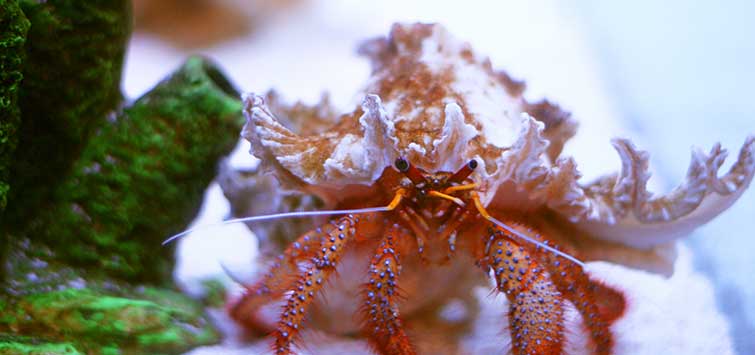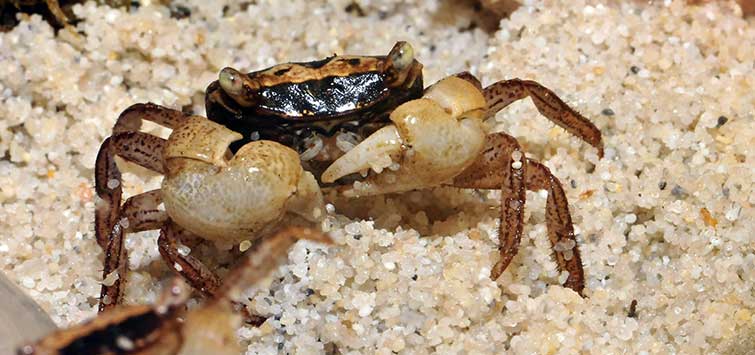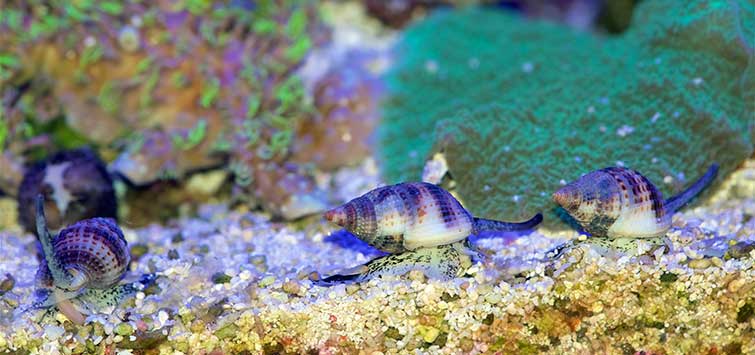At Home with Hermit Crabs
Author: Richard Aspinall
“Tough,” “small,” “useful,” and “interesting” are four words that accurately describe the hardy group of invertebrates boasting more than 1100 species: the hermit crab of the superfamily Paguroidea.
My Love for Hermit Crabs
I’ve long had a fascination with these remarkable crustaceans, which started at least two decades before I set up my first marine aquarium. As a kid, I spent a lot of time on holiday visiting the UK coast, exploring shores and rockpools that were like windows into a mesmerizing world that time and the tides would reveal to me twice a day.
Back then, I couldn’t think of anything more exciting than pushing aside seaweed and lifting up limpet-covered rocks to reveal blennies, shrimps, starfish, and (of course) hermit crabs. It was on one of these seaside expeditions that I first encountered these engaging little creatures. They appeared to stare back at me, with beady eyes at the end of stalks, waving one claw that was larger than the other.
Those early days investigating rockpools were directly responsible for my later love of scuba diving and marine aquaria. After the purchase of a pair of percula clownfish (Amphiprion percula), hermit crabs were the next animals I bought as I began what would become my life-long passion as a home aquarist. As I soon discovered, they are fascinating invertebrates whose unique biology, entertaining behavior, and practicality make them a great addition to the marine tank.
Homes for Hermits
Hermit crabs can be found across all the seas and oceans of the world. However, the majority of species are found within temperate and tropical regions. More closely related to squat lobsters than they are to true crabs, they reside within the superfamily Paguroidea. Within this division are seven more families, but most of the species that will interest hobbyists are largely found in the Paguridae and Diogenidae families.
One of most popular, the family Coenobitidae—which differs from its ocean-dwelling cousins in their choice of living arrangements—contains two genera: Coenobita, which comprises 17 terrestrial species, and the monotypic genus Birgus, which contains the world’s largest land-living arthropod, the coconut crab (Birgus latro).
Exoskeletons
Clearly, however, the most fundamental and obvious feature of hermit crabs is their reliance upon a hard shelter that affords them protection from predation. This means they can dispense with the need to grow an exoskeleton—however, a “homeless” hermit will be easily eaten! You will note that I don’t immediately refer to their shelters as shells. This is because not all species use them exclusively; some have been recorded using tusk shells, pieces of bamboo, or plastic components dumped by humans. Some hermits, such as Discorsopagurus schmitti, inhabit the empty tubes of tubeworms such as feather duster worms (Sabellastarte fallax), and they may enter aquaria as hitchhikers on live rock. However, hermit crabs mainly use the shells of gastropod mollusks.
Many species, like the common scarlet reef hermit crab (Paguristes cadenati) and the red-legged hermit (P. digueti), will occupy a range of gastropod shells with wide openings. Because they are frequent habitat hoppers, it’s entertaining to collect suitable, empty whelk and periwinkle shells from the local sea shore, and then observe the hermits investigating and moving into a new abode if a particular one is to their liking. This activity often results in a vacancy chain in which just about every individual moves up the housing ladder when a shell immediately above the size of their own becomes free.
Finding New Homes
In the wild, shell availability will limit growth potential. This sometimes creates a situation where small hermits, limited to small shells found near the shore, are as mature as larger specimens found at depths where bigger shells are accessible. So when you add new shells to your tank for them, you may find that they have moulted their exoskeleton and increased in size. Moulted exoskeletons can be mistaken for dead crabs, but the emergence of a slightly larger and newly housed hermit will reassure you.
Anemone-Carrying Crabs
Of particular interest to biologists are the anemone-carrying crabs. Three species in the genus Dardanus have developed a symbiotic relationship with anemones: D. pedunculatus, D. tinctor, and D. deformis. These sizeable animals occupy large shells such as whelks and, as the name suggests, have anemones attached to them. The anemones afford protection with their stinging tentacles and benefit by collecting morsels of food left over from the hermit’s messy meals. Hermits take the anemones with them when they upgrade shells, and they will collect more if the opportunity arises.
Clawing to the Top
Hermit crabs are “handed;” that is, one pincer is larger than the other. In fact, pincer sizes and coloration vary between species. Handedness is commonplace in the world of these crustaceans. The overall majority of gastropod shells curl to the right (dextral) rather than to the left (sinistral). This varies amongst genera and species with some exceptions—some species have equally handed specimens, whereas some are almost exclusively one way or another; but overall, shells are dextral.
The current status quo of dexterity may be maintained due to ease of mating, though according to fossil records it has changed over geological time, with a shift in the ratio of dextral to sinistral specimens. Most hermits are dextral adapted, meaning they have a larger right pincer. However, in the Diogenidae family, it’s the left claw that is enlarged.
Proper Crab Care
There is, perhaps, no animal more misused in the aquarium industry than the hermit crab. Aquarists will often buy them in great numbers, and then introduce them to a newly set-up tank to control algae issues as part of the maturation process. Sadly, many will starve for lack of suitable foodstuffs once their job is done, and they subsequently die. In some cases, the aquarist may still be left with outbreaks of troublesome algae, such as Valonia and Derbesia spp., which resist any attempts to be controlled with a clean-up crew.
Feeding
That said, hermit crabs can be a useful component to keeping a tank clean, but do not overstock them. I would suggest that in many modern reef tanks you may only need half a dozen individuals to benefit from their services. Keep in mind that you’ll probably have to offer supplemental feeding. Mine always enjoy algae discs commonly sold for freshwater fish. Hermits tend toward being omnivorous; they are not solely vegetarian, as many people believe. This, of course, prompts the question: are hermits reef-safe? Yes and no.
Are Hermits Reef-Safe?
I personally have not had issues with standard rock hermits, including the attractive blue-legged hermit crab (Clibanarius tricolor), except that some have killed cerith snails (Cerithium spp.) and used their shells. I’ve had reason to suspect the gorgeous blue-knuckle hermit (Calcinus elegans), also known as the electric blue hermit crab, of contributing to the demise of a few large-polyp stony corals and turbo snails before I realized what was happening. There are some well-respected authors who state that there is no such thing as 100-percent certainty when it comes to hermits being entirely reef-safe. Perhaps, like many animals, they may not turn predatory if you ensure they are well fed and not overstocked in the tank.
Significantly larger species, such as the giant hermit crab (Petrochirus diogenes) and the Halloween hermit crab (Ciliopagurus strigatus), are going to be a real threat due to their formidable size and ability to physically damage corals and knock over unsecured live rock. Some aquarists will report problems and some will not, though it’s a story you will hear often in the hobby.
Caution with Corals
It’s worth noting that hermit crabs are capable of knocking unsecured corals off of live rock. Coral fragments, and even colonies, can be dislodged as they work their way through the tank. They can also become stuck to Acropora colonies while exploring coral branches. Their shell can become lodged in a position in which their claws cannot push them off. In this instance, it’s important to physically remove them. If they remain stuck there, they will not only slowly starve, but they will also block light penetration, which can damage coral tissue.
The Joy of Hermits
Hermit crabs will, on the whole, be useful in your tank. They will deal with dead animals you cannot find, they may contribute to algae reduction, and their constant foraging will place detritus into the water column for later removal by your filtration system. Even better, they are captivating creatures that are fun to watch. On occasion, I drop a clam or mussel into my tank and take great delight in watching them throw themselves off the rockwork and race to the food. One or two hermits will grab hold of it while hungry fish pick away at the choice flesh.
Hermits are very tenacious and give the appearance of being “tough customers” with loads of personality. Though this may be anthropomorphism of the worst kind, it can’t be denied that they are very likable. We may characterize them as cute and comical, but they are highly adapted miracles of design that have found—and benefited from—an unexploited ecological niche.
I encourage you to enjoy them for the marvelous creatures they are. Celebrate them, take care of them, and delight in watching them always on the move, selecting and upgrading their homes. You may also want to consider aquascaping areas of rockwork that reach just above the surface so you can observe their natural behaviors. If you look after them and properly address their needs, they will keep entertaining you for years to come.

.png?h=595&iar=0&w=2781&hash=5FD5E69473BCC22199FBFA2FB71B6033)



